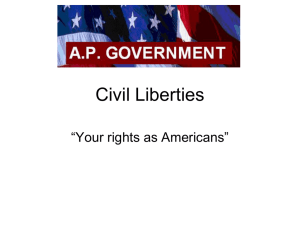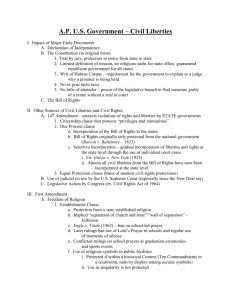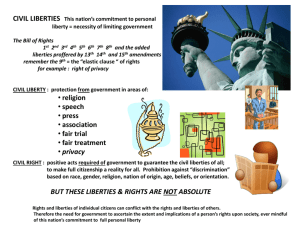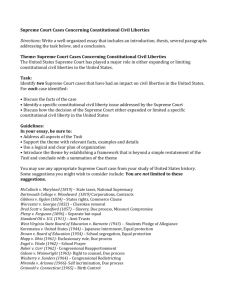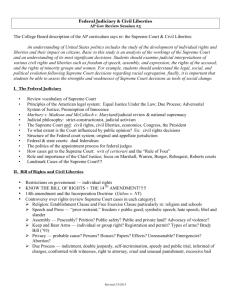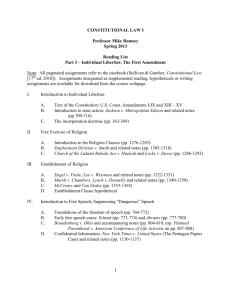File
advertisement
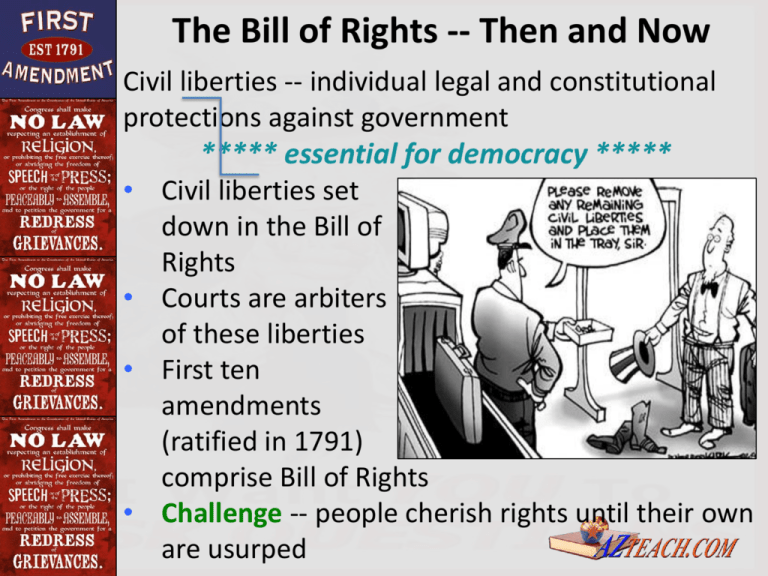
The Bill of Rights -- Then and Now Civil liberties -- individual legal and constitutional protections against government ***** essential for democracy ***** • Civil liberties set down in the Bill of Rights • Courts are arbiters of these liberties • First ten amendments (ratified in 1791) comprise Bill of Rights • Challenge -- people cherish rights until their own are usurped The Bill of Rights -- Then and Now Civil Liberties • Civil liberties include freedom of speech, freedom of religion, and freedom of the press, as well as guarantees of a fair trial Civil Rights • Civil rights sometimes reserved for those positive acts of government that seek to make constitutional guarantees a reality for all people The Bill of Rights and the states The scope of the Bill of Rights • In 1791, every state constitution included a bill of rights • First ten amendments were intended to restrict the new federal government, not the existing state governments • Note First Amendment begins with the words, “Congress shall make no law…” The Bill of Rights and the states Barron v. Baltimore (1833) • John Marshall -- Bill of Rights “contains no expression indicating an intention to apply them to the state government. The court cannot so apply them.” • Supreme Court established a precedent that the freedoms guaranteed by the Bill of Rights did not restrict the state governments The Bill of Rights and the states Fourteenth Amendment • Contains two keys clauses that have had a significant impact on Supreme Court decisions and U.S. politics: • Due Process Clause • Equal Protection Clause The Bill of Rights and the states Gitlow v. New York (1925) • Court says freedoms of speech and press “were fundamental personal rights and liberties protected by the due process clause of the Fourteenth Amendment from impairment by the states” The Incorporation Doctrine • Barron v. Baltimore, Supreme Court ruled that federal courts could not stop enforcement of state laws that restricted the rights enumerated in the Bill of Rights • Gitlow v. New York began the incorporation process of using the Due Process Clause of the Fourteenth Amendment to extend most of the requirements of the Bill of Rights to the states • Incorporation process did not occur at once -gradual process by which Supreme Court has used a series of individual decisions to incorporate the Bill of Rights into the Due Process Clause of the Fourteenth Amendment Freedom of Religion The First Amendment • America’s religious liberties originated in colonial opposition to government-sponsored churches • 1st Amendment contains two fundamental guarantees of religious freedom: • Establishment Clause prohibiting “an establishment of religion…” • Free Exercise Clause prohibits government from interfering with the practice of religion • Note: both these protections have been extended to the states by the Due Process Clause of the Fourteenth Amendment Freedom of Religion Establishment clause • • • “Congress shall make no law respecting an establishment of religion.” • Clearly prohibits an establishment of a national church What else was meant by this? TJ argued that 1st Amendment created a “wall of separation” between church and state, which would prohibit not only favoritism but any support for religion at all "It does me no injury for my neighbor to say there are twenty gods, or no God. It neither picks my pocket nor breaks my leg.” -- TJ Freedom of Religion Establishment clause School prayer: Engel v. Vitale (1962) • NY State Board of Regents approved a prayer for recital each morning in New York public schools • Engel (a parent in the district) argued that the Regents’ prayer violated the Establishment Clause of the First Amendment as applied to the states through the Fourteenth Amendment • Supreme Court ruled that state-sponsored prayer in public schools was an unconstitutional violation of the Establishment Clause that “breaks the constitutional wall of separation between Church and State.” Freedom of Religion Establishment clause Aid to parochial schools: Lemon v. Kurtzman (1971) • Supreme Court declared that aid to church-related schools must meet the following three tests: • The test (Lemon Test) -①Statute must have a secular purpose ②Primary effect of the statute should not be to advance or inhibit religion ③Statute must not excessively entangle government with religion Freedom of Religion Establishment clause Zelman v. Simmons-Harris (2002) Court upheld (it’s OK) program that provided some families in Cleveland, Ohio, with vouchers that could be used to pay tuition at religious schools "The place of religion in our society is an exalted one, achieved through a long tradition of reliance on the home, the church and the inviolable citadel of the individual heart and mind. We have come to recognize through bitter experience that it is not within the power of government to invade that citadel, whether its purpose or effect be to aid or oppose, to advance or retard. In the relationship between man and religion, the State is firmly committed to a position of neutrality.” -- Justice Tom Clark Abington School District v. Schempp (1963) (School-sponsored Bible reading in public schools in the United States to be unconstitutional) Freedom of Religion Free Exercise Clause General Points • First Amendment’s Free Exercise Clause guarantees each person the right to believe what they want • Religion cannot make an act legal that would otherwise be illegal • Government can act when religious practices violate criminal laws, offend public morals, or threaten community safety • Example, in Oregon v. Smith (1990), SC banned the use of illegal drugs in religious ceremonies Freedom of Religion Free Exercise Clause Limits on the Free Exercise Clause: Reynolds v. United States (1879) Issue – Polygamy “duty to marry many women” • SC made an important distinction between religious beliefs and religious practices • Court cannot restrict what a person believes because that “lies solely between a man and his God.” • (However) society has a right to legislate against religious activities that violate a law of the land • SC rules against Reynolds, arguing that permitting polygamy would “make the professed doctrines of religious belief superior to the law of the land, and in effect to permit every citizen to become a maw unto himself.” Freedom of Speech and Press Does “no law” in the First Amendment really mean “no law”? Is freedom of expression absolute? -- Not always! IMPORTANT -- Must find a balance between freedom of expression and competing values like public order, national security, and the right to a fair trial What exactly is speech? (like picketing) -- non verbal – symbolic speech? Freedom of Speech and Press The Defense of Free Speech The First Amendment • Framers believed right to free speech is a fundamental natural right • 1st AM clearly states that, “Congress shall make no law… abridging the freedom of speech or of the press.” • First and Fourteenth Amendments protect free speech from incursions of both federal and state governments Freedom of Speech and Press The Defense of Free Speech Protections of unpopular views • Guarantees of free speech are intended to protect expressions of unpopular views • “The freedom to differ,” Justice Jackson wrote, “ is not limited to things that do not matter much.” • Even if a doctrine is “wrong,” it does not follow that it should be silenced • English philosopher John Stuart Mill argued that wrong or offensive ideas force us to sharpen our own views • IF we believed in free expression, we must believe in its power to overcome error in a fair debate Freedom of Speech and Press The “Clear and Present Danger” Test Schenck v. United States (1919) • • • • Espionage Act of 1917 prohibited forms of dissent deemed to be harmful to the nation’s war effort in World War 1 Charles Schenck opposed America’s participation in World War I so he mailed 15,000 leaflets to potential draftees comparing military conscription to slavery and urged his readers to “assert your rights” by resisting the military draft Government responded by arresting Schenck for violating the Espionage Act Schenck argued Espionage Act unconstitutional because it violated the 1st Amendment’s promises of free speech Freedom of Speech and Press The “Clear and Present Danger” Test Justice Oliver Wendell Holmes wrote, “[T]he character of every act depends on the circumstances in which it is done. The most stringent protection of free speech would not protect a man in falsely shouting fire in a theatre, and causing a panic… The question in every case is whether the words are used in such circumstances and are of such a nature as to create a clear and present danger that they will bring about substantive evils that Congress has the right to prevent.” Freedom of Speech and Press The “Clear and Present Danger” Test • Clear and present danger test created a precedent that First Amendment guarantees of free speech are not absolute • Smith Act of 1940 forbade advocacy of violent overthrow of American government • Free speech advocates did little to stem the relentless persecution known as McCarthyism during the “cold war” of the 1950s, when Senator Joseph McCarthy’s unproven accusations that many public officials were Communists created an atmosphere in which broad restrictions were placed on freedom of expression Freedom of Speech and Press The “Clear and Present Danger” Test • 1960s, political climate changed Court narrowed interpretation of Smith Act so that government could no longer use it to prosecute dissenters Brandenburg v. Ohio (1969) • SC limited the clear and present danger test by ruling that the government could punish the advocacy of illegal action only if “such advocacy is directed to inciting or producing imminent lawless action and is likely to incite or produce such action.” Freedom of Speech and Press Limits on Free Speech Libel and Slander • libel -- publication of statements known to be false that tend to damage a person’s reputation • slander -- spoken defamation Not protected by the First Amendment! • Libel / slander involve freedom of expression issues that involve competing values • If public debate is not free, no democracy • Conversely, some reputations may be unfairly damaged in process Freedom of Speech and Press Limits on Free Speech Libel and Slander • • • Court says statements about public figures are libelous only if made with malice and reckless disregard for the truth New York Times v. Sullivan (1964), SC ruled statements about public figures are libelous only when both false and purposely malicious Private persons only need to show that statements about them were defamatory falsehoods and that the author was negligent Freedom of Speech and Press Limits on Free Speech Obscenity • Public standards vary from time to time, place to place, and person to person • Work that some call “obscene” may be “art” to others • No nationwide consensus exists that offensive material should be banned Freedom of Speech and Press Limits on Free Speech Obscenity • Roth v. United States (1957), Supreme Court ruled that “obscenity is not within the area of constitutionally protected speech or press.” Problem – What is obscene??? Freedom of Speech and Press Limits on Free Speech Obscenity Miller v. California (1973) • Court tried to clarify what could be classified as obscene • Chief Justice Warren Burger wrote that materials were obscene if the work, taken as a whole, appealed to a “prurient interest” in sex; and if it showed “patently offensive sexual contact”; and if it “lacked serious artistic, literary, political, or scientific merit.” • Miller, Court ruled decisions should be made to reflect standards of local (not national) communities Freedom of Speech and Press Limits on Free Speech Symbolic speech • Symbolic speech includes forms of nonverbal communication such as carrying signs, wearing armbands, or burning flags • Tinker v. Des Moines Independent School District (1969) • Free expression case • Justice Abe Fortas states that students and teachers do not “shed their constitutional right to freedom of speech or expression at the school house gate.” Freedom of Speech and Press Limits on Free Speech Symbolic speech • Texas v. Johnson (1989), SC ruled that flag burning is a form of symbolic speech protected by 1st Am. • Note SC has ruled 1st Amendment does not protect symbolic speech intended to incite illegal actions • Example, states may make it a crime to burn a cross with the intent to threaten racial terror Freedom of Speech and Press Free press versus free trial Bill of Rights is a source of potential conflicts between different types of freedoms • Constitution clearly meant to guarantee the right to a fair trial as well as the right to a free press Problem: Trial may not be fair if pretrial press coverage makes it impossible to select an impartial jury Freedom of Speech and Press Prior Restraint • Prior restraint attempt to limit freedom of press by preventing material from being published • Prior restraint is thus a form of censorship • Supreme Court has repeatedly ruled that prior restraint is a violation 1st Amendment protection of freedom of press • Important test cases have included Near v. Minnesota (1931) and New York Times Company v. United States (1971) Freedom of Speech and Press Prior Restraint Hazelwood School District v. Kuhlmeier (1988) • Supreme Court ruled school administrators can exercise “editorial control over the style and content of student speech in school-sponsored expressive activities so long as their actions are reasonably related to legitimate pedagogical concerns.” Freedom of Assembly Freedom of assembly • • Constitutional basis for forming interest groups / political parties, for picketing and protesting in groups Two facets of freedom of assembly • Right to assemble • Right to associate Freedom of Assembly Right to assemble • • Right to gather together in order to make a statement within reasonable limits • Called time, place, and manner restrictions • Includes rights to parade, picket, protest Supreme Court has generally upheld the right of any group -- no matter how controversial or offensive – to peaceably assemble on public property • Balance between freedom and order • When does protest verge on harassment? • Westboro Baptist Church Freedom of Assembly Right to associate • Freedom to associate with people who share a common interest • Includes right to meet with people who want to create political change • Court found Alabama’s attempt to require NAACP to turn over its membership list to be an unconstitutional restriction of freedom of association • NAACP v. Alabama (1958) Rights of the Accused Interpreting defendants’ rights • First Amendment guarantees freedoms of religion, speech, press, assembly • Most of remaining rights in the Bill of Rights concern rights of people accused of crimes • Rights were originally intended to protect accused in political arrests and trials • Today -- protections in Fourth, Fifth, Sixth, Eighth Amendments are primarily applied in criminal justice cases • Language of the B of R vague, defendants’ rights are not well defined • Incorporation -- these rights at state level as well Rights of the Accused Rights in the original Constitution Constitution expressly states, “The Privilege of the Writ of Habeas Corpus shall not be suspended, unless when in cases of Rebellion or Invasion the public safety may require it.” • Writ of habeas corpus is a court order directing that a prisoner be brought before a court and that court officers show cause why the prisoner should not be released • Writ of habeas corpus thus prevents unjust arrests and imprisonments Rights of the Accused Rights in the original Constitution Bills of Attainder • Constitution prohibits Congress and the state legislatures from passing a bill of attainder • Legislative act that provides for the punishment of a person without a court trail Ex post facto laws • Constitution prohibits Congress and the state legislatures from enacting ex post facto laws • Ex post facto law is a law applied to an act committed before the law was enacted Rights of the Accused Search and Seizures • 4th Amendment declares, “The right of the people to be secure in their persons, houses, papers, and effects, against unreasonable searches and seizures, shall not be violated….” Rights of the Accused The exclusionary rule • Exclusionary rule prohibits evidence obtained by illegal searches or seizures from being admitted in court • Supreme Court first established the exclusionary rule in Weeks v. United States (1914) • Mapp v. Ohio (1961) • Case illustrates process of incorporation by which the Fourth Amendment was applied to the states through the Due Process Clause of the Fourteenth Amendment Rights of the Accused The Miranda Rule • The Fifth Amendment forbids forced self-incrimination, stating that no person “shall be compelled to be a witness against himself.” • Suspects cannot be compelled to provide evidence that can be used against them • Burden of proof rests on police and prosecutors, not the defendant • Right applies to congressional hearings and police stations, as well as to courtrooms Rights of the Accused Miranda v. Arizona (1966) • Set guidelines for police questioning of suspects • Suspects must be informed of their constitutional right to remain silent • Suspects must be warned that what they say can be used against them in a court of law • Suspects must be told that they have a right to have a lawyer present during • Questioning, and that a lawyer will be provided if the accused cannot afford one "You have the right to remain silent. Anything you say can and will be used against you in a court of law. You have the right to have an attorney present during questioning. If you cannot afford an attorney, one will be appointed for you. Do you understand these rights? " Rights of the Accused Arizona v. Fulminante (1991) • Court held that a coerced confession is “harmless error” if other evidence is sufficient for conviction • If law enforcement officials encourage persons to commit crimes (such as accepting bribes or purchasing illicit drugs) that they otherwise would not commit, convictions for these crimes will be overturned by the courts Rights of the Accused The Right to Counsel • 6th Amendment states, “The accused shall enjoy the right… to have the assistance of counsel for his defense.” • Note when Sixth Amendment was ratified, • that right did not apply to • people tried in states courts Rights of the Accused The Right to Counsel Gideon v. Wainwright (1963) • Gideon was accused of breaking and entering a Florida poolroom and stealing a small amount of money • Judge refused Gideon’s request for a court-appointed free lawyer • Gideon appealed his conviction, arguing that by refusing to appoint a lawyer to help him, the Florida court violated his rights promised by the Sixth and Fourteenth Amendments • Unanimous decision, the Supreme Court ruled that to those accused of major crimes under state laws • This landmark case illustrates the process of incorporation, by which the Sixth Amendment was applied to the states through the Due Process Clause of the Fourteenth Amendment. Rights of the Accused Rights of the Accused Eighth Amendment -- forbids cruel and unusual punishment What does that mean??? • Most constitutional debate over cruel and unusual has centered on death penalty • Gregg v. Georgia (1976) • found death penalty is “an extreme sanction, suitable to the most extreme of crimes” • Court has recently held constitutionally unacceptable to execute 16- or 17-year-olds or mentally challenged persons • death sentences in steep decline today due to DNA testing and public concerns over wrongful sentences The rights to privacy and abortion rights The right to privacy • • Justice Louis D, Brandeis defined privacy as “the right to be left alone.” Bill of Rights doesn’t specifically grant Americans a right to privacy • (However) following constitutional provisions imply a right to privacy: • 1st AM’s guarantee of freedom of religion • 3rd AM’s prohibition against the government forcing citizens to quarter soldiers in their homes • 4th AM’s protection against unreasonable searches and seizures • 5th AM’s rule that private property cannot be seized without “due process of law.” The rights to privacy and abortion rights Griswold v. Connecticut (1965) • Estelle Griswold challenged constitutionality of an 1879 Connecticut law that prohibited the use of “any drug, medicinal article or instrument for the purpose of preventing conception.” • Supreme Court ruled the Connecticut law criminalizing the use of contraceptives violated the right to marital privacy • Justice William O. Douglas argued that the right to privacy was found in the unstated liberties implied by the explicitly stated state rights in the Bill of Rights or “penumbras” • penumbras -- unstated liberties implied by explicitly stated rights The rights to privacy and abortion rights Right to privacy established in Griswold v. Connecticut set an important precedent for Roe v. Wade Roe v. Wade (1973) • Jane Roe (A pseudonym for Norma McCorvey) challenged constitutionality of a Texas law allowing abortions only to save the life of the mother • Roe argued that the decision to obtain an abortion should be protected by the right to privacy implied in the Bill of Rights • The Supreme Court struck down the Texas law by a vote of 7 to 2 The rights to privacy and abortion rights Challenges to Roe Webster v. Reproductive Health Services (1989) • Supreme Court upheld a Missouri law prohibiting abortion (except those preserving the mother’s health) in any publicly operated hospital or clinic in Missouri Planed Parenthood of Southeastern Pennsylvania v. Casey (1992) • Supreme Court ruled that a state may place reasonable limits that do not place an “undue burden” on a woman’s right to have an abortion • Example, a state may impose a 24-hlour waiting period and require parental consent for minors Understanding Civil Liberties American government: • Democratic (because it is governed by officials elected by the people and answerable to them) and • Constitutional (because it has a fundamental organic law, the Constitution, that limits the things government can do) • Democratic and constitutional components of government can produce conflicts, but they also reinforce one another Understanding Civil Liberties Civil liberties and democracy • Individual rights may conflict with other values • Rights guaranteed by the First Amendment are essential to a democracy • Individual participation and the expression of ideas are crucial components of democracy HOWEVER • So is majority rule, which can conflict with individual rights • Rights guaranteed by Fourth, Fifth, Sixth, and Eighth Amendments protect all Americans BUT • They also make it harder to punish criminals Understanding Civil Liberties Civil liberties and democracy • Ultimately, the courts decide what constitutional guarantees mean in practice: • Federal courts are the branch of government least subject to majority rule • Courts enhance democracy by protecting liberty and equality from the excesses of majority rule Understanding Civil Liberties Civil liberties and the scope of government • Today’s government is huge and commands vast, powerful technologies • Since Americans can no longer avoid the attention of government, strict limitations on governmental power are essential -- limitations that are provided by the Bill of Rights (Freedom v. Order dilemma) • In general, civil liberties limit the scope of government

